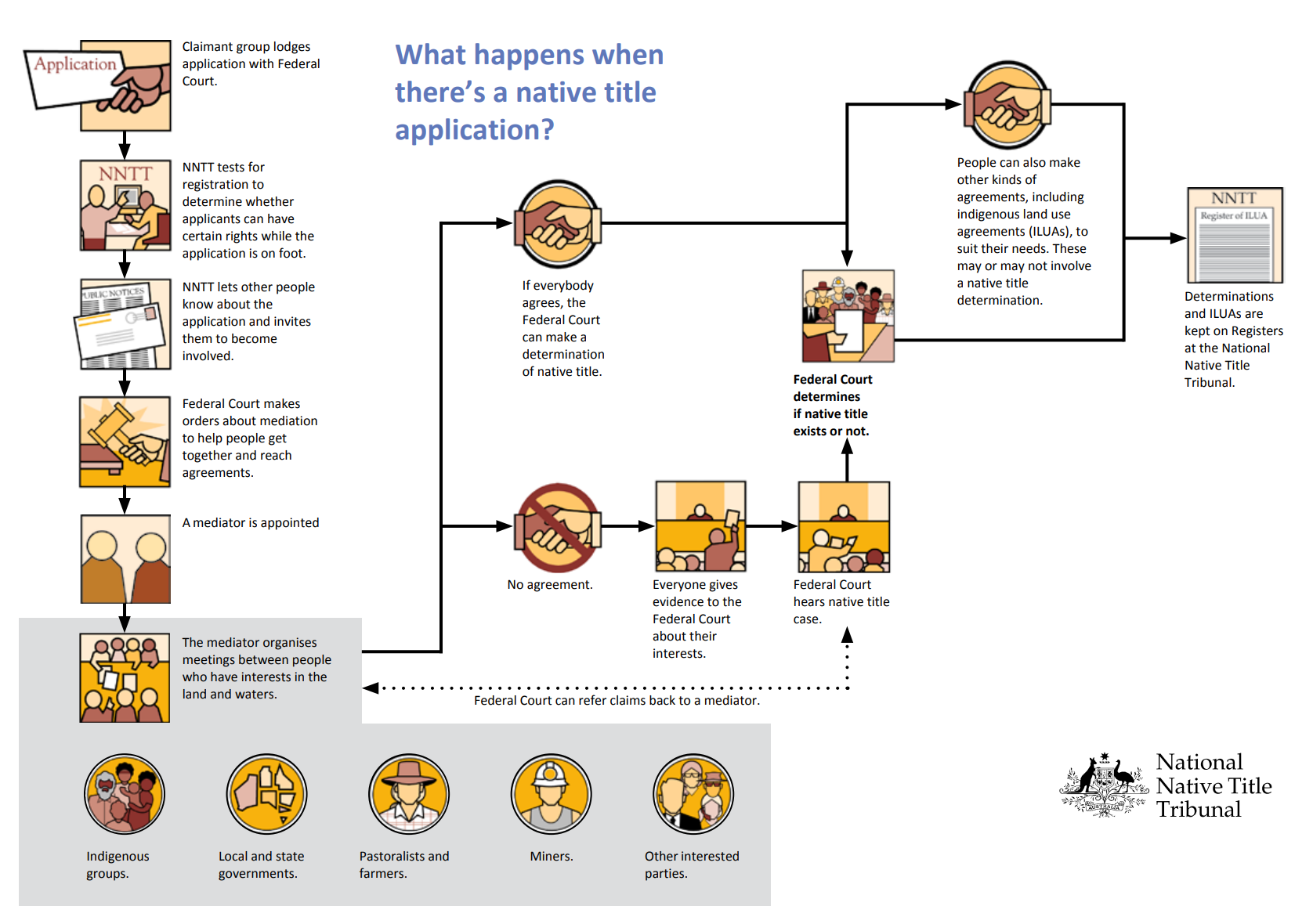M4 - Learner Manual
7. The Role of Courts, Tribunals and Aboriginal Land Councils
The Federal Court
The Federal Court of Australia is responsible for the management of all applications made under the Native Title Act 1993 (Cth) or a determination of native title or for compensation for the loss or impairment of native title. Those applications must be filed in the court.
As of 1 July 2012, the Federal Court is also responsible for mediation of native title claims and Aboriginal and Torres Strait Islander Land Use Agreements (ILUA) negotiations related to native title claims mediation.
The court has wide powers to manage native title cases. It can:
- make directions about how the application is to be progressed
- decide whether or not the application should be referred to the National Native Title Tribunal or another appropriate person or body for mediation
- determine who are the ‘parties’ to the application
- adjourn the proceedings to allow time for the parties to negotiate
- make orders to ensure that native title applications which cover the same area are dealt with in one proceeding
- strike out or dismiss an application, which brings the case to an end
- set an application down for hearing
- make a determination recognising that native title does, or does not, exist
- decide whether compensation for the loss or impairment of native title should be paid.
The National Native Title Tribunal
The National Native Title Tribunal was set up under the Native Title Act 1993 (Cth) and commenced operations in January 1994. The Tribunal is an independent statutory body with a wide range of statutory functions. It also provides services, including the provision of information and assistance to persons involved in native title processes and the wider public. The Tribunal administers part of the Future Act process - that is, generally, the process that deals with future acts relating to mining and some compulsory acquisitions.
The Tribunal's role includes mediating between parties, conducting inquiries and making decisions (called 'future act determinations') where parties can't reach agreements. In addition the Tribunal also manages ILUA negotiations that are not related to native title claims mediation.
The Tribunal also maintains the Registers of Native Title Claims, Native Title Determinations and Aboriginal and Torres Strait Islander Land Use Agreements.[1]
Aboriginal and Torres Strait Islander Land Use Agreements
ILUAs are voluntary agreements between native title groups and other interested parties about the use of land and waters. The ILUAs allow people to negotiate flexible agreements that suit their particular circumstances. ILUAs can be entered into whether or not there is a native title claim over the area.
ILUAs may cover topics such as:
- native title holders agreeing to future development
- access to an area and cultural heritage
- extinguishment or coexistence of native title
- compensation
- employment and economic opportunities for native title groups
Upon registration, ILUAs bind all parties, including native title holders, to the terms of the agreement.[2]
Aboriginal Land Councils
Local Aboriginal Land Councils are organisations run by Aboriginal and Torres Strait Islander people that assist in the claiming and management of traditional lands. Many Land Councils include information about land rights and why land is important to Aboriginal people.[3] Land Councils give Aboriginal peoples a voice on issues affecting their lands, seas and communities.[4]
The Aboriginal Land Rights (Northern Territory) Act 1976 established the basis upon which Aboriginal people in the Northern Territory could claim rights to land based on traditional occupation. Under the Act, land councils represent Aboriginal people with “statutory authority”, i.e. authorised to enforce legislation on their behalf. Land councils also have responsibilities under the Native Title Act 1993 (Cth) and the Pastoral Land Act 1992 (Cth).
There are 120 Local Aboriginal Land Councils located across NSW. Local Aboriginal Land Councils form the core of the organisational structure of the land rights network. Local Aboriginal Land Council boundaries do not necessarily affiliate with cultural or traditional association with country.[5] The boundaries of LALCs were set in the Aboriginal Land Rights Act 1983 (NSW).[6] Section 87 of the Act allows for changes of these boundaries to be made.
The NSW Aboriginal Land Council is an independent statutory corporation constituted under the Aboriginal Land Rights Act 1983. The Council is elected every four years and is comprised of nine counsellors representing nine regional areas.
Local Aboriginal Land Councils have many tasks and responsibilities including:
· To provide a strong voice for the Aboriginal people they represent
· To help Aboriginal people reclaim their country through appropriate avenues
· To help Aboriginal people manage their land
· To consult with landowners on mining activity, employment, development and other land use proposals
· To protect Aboriginal culture and sacred sites
· To assist with economic projects on Aboriginal land
· To promote community development and improve service delivery
· To fight for legal recognition of Aboriginal people’s rights
· To help resolve land disputes, native title claims and compensation cases
· To run the permit system for visitors to Aboriginal land and deal with illegal entry to lands
· To pursue cultural, social and economic independence for Aboriginal people[7]
What Happens When There’s a Native Title Application?

[1] National Native Title Tribunal <http://www.nntt.gov.au/Information-about-native-title/Pages/The-Native-Title-Act.aspx>
[2] National Native Title Tribunal, Steps to an ILUA, [online] Available at http://www.nntt.gov.au/ILUAs/Pages/Registration-of-ILUAs.aspx [Accessed 3/10/14]
[3] ReconciliACTION Fact sheet <http://reconciliaction.org.au/nsw/education-kit/land-rights/>
[4]<http://australia.gov.au/people/indigenous-peoples/land-councils>
[5] Office of Communities, Aboriginal Affairs <http://www.aboriginalaffairs.nsw.gov.au/alra/nsw-and-local-aboriginal-land-councils/>
[6] Creative Spirits < http://www.creativespirits.info/aboriginalculture/selfdetermination/aboriginal-land-councils>
[7] Creative Spirits, Aboriginal Land Councils < http://www.creativespirits.info/aboriginalculture/selfdetermination/aboriginal-land-councils>
